Yifan Hu
Bridging Past and Future: Distribution-Aware Alignment for Time Series Forecasting
Sep 17, 2025Abstract:Representation learning techniques like contrastive learning have long been explored in time series forecasting, mirroring their success in computer vision and natural language processing. Yet recent state-of-the-art (SOTA) forecasters seldom adopt these representation approaches because they have shown little performance advantage. We challenge this view and demonstrate that explicit representation alignment can supply critical information that bridges the distributional gap between input histories and future targets. To this end, we introduce TimeAlign, a lightweight, plug-and-play framework that learns auxiliary features via a simple reconstruction task and feeds them back to any base forecaster. Extensive experiments across eight benchmarks verify its superior performance. Further studies indicate that the gains arises primarily from correcting frequency mismatches between historical inputs and future outputs. We also provide a theoretical justification for the effectiveness of TimeAlign in increasing the mutual information between learned representations and predicted targets. As it is architecture-agnostic and incurs negligible overhead, TimeAlign can serve as a general alignment module for modern deep learning time-series forecasting systems. The code is available at https://github.com/TROUBADOUR000/TimeAlign.
UniTalker: Conversational Speech-Visual Synthesis
Aug 06, 2025Abstract:Conversational Speech Synthesis (CSS) is a key task in the user-agent interaction area, aiming to generate more expressive and empathetic speech for users. However, it is well-known that "listening" and "eye contact" play crucial roles in conveying emotions during real-world interpersonal communication. Existing CSS research is limited to perceiving only text and speech within the dialogue context, which restricts its effectiveness. Moreover, speech-only responses further constrain the interactive experience. To address these limitations, we introduce a Conversational Speech-Visual Synthesis (CSVS) task as an extension of traditional CSS. By leveraging multimodal dialogue context, it provides users with coherent audiovisual responses. To this end, we develop a CSVS system named UniTalker, which is a unified model that seamlessly integrates multimodal perception and multimodal rendering capabilities. Specifically, it leverages a large-scale language model to comprehensively understand multimodal cues in the dialogue context, including speaker, text, speech, and the talking-face animations. After that, it employs multi-task sequence prediction to first infer the target utterance's emotion and then generate empathetic speech and natural talking-face animations. To ensure that the generated speech-visual content remains consistent in terms of emotion, content, and duration, we introduce three key optimizations: 1) Designing a specialized neural landmark codec to tokenize and reconstruct facial expression sequences. 2) Proposing a bimodal speech-visual hard alignment decoding strategy. 3) Applying emotion-guided rendering during the generation stage. Comprehensive objective and subjective experiments demonstrate that our model synthesizes more empathetic speech and provides users with more natural and emotionally consistent talking-face animations.
Unraveling Interwoven Roles of Large Language Models in Authorship Privacy: Obfuscation, Mimicking, and Verification
May 20, 2025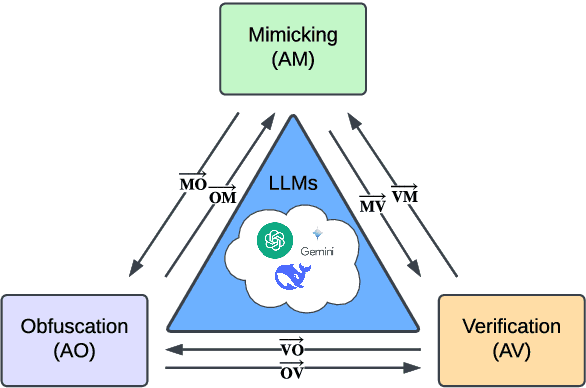
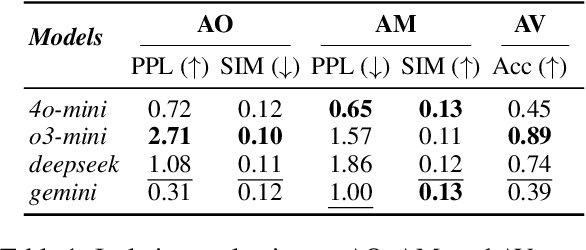
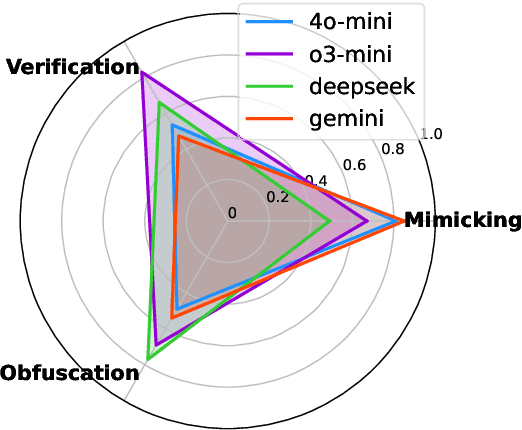
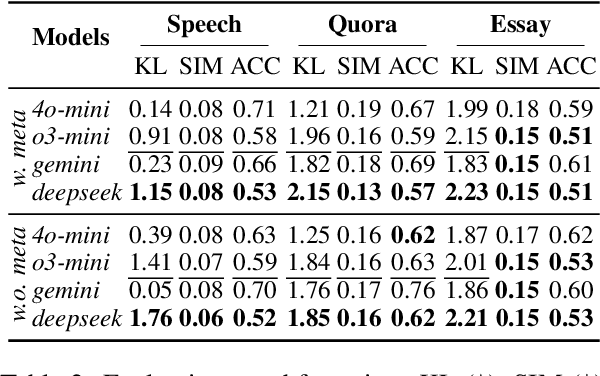
Abstract:Recent advancements in large language models (LLMs) have been fueled by large scale training corpora drawn from diverse sources such as websites, news articles, and books. These datasets often contain explicit user information, such as person names and addresses, that LLMs may unintentionally reproduce in their generated outputs. Beyond such explicit content, LLMs can also leak identity revealing cues through implicit signals such as distinctive writing styles, raising significant concerns about authorship privacy. There are three major automated tasks in authorship privacy, namely authorship obfuscation (AO), authorship mimicking (AM), and authorship verification (AV). Prior research has studied AO, AM, and AV independently. However, their interplays remain under explored, which leaves a major research gap, especially in the era of LLMs, where they are profoundly shaping how we curate and share user generated content, and the distinction between machine generated and human authored text is also increasingly blurred. This work then presents the first unified framework for analyzing the dynamic relationships among LLM enabled AO, AM, and AV in the context of authorship privacy. We quantify how they interact with each other to transform human authored text, examining effects at a single point in time and iteratively over time. We also examine the role of demographic metadata, such as gender, academic background, in modulating their performances, inter-task dynamics, and privacy risks. All source code will be publicly available.
Chain-Talker: Chain Understanding and Rendering for Empathetic Conversational Speech Synthesis
May 19, 2025Abstract:Conversational Speech Synthesis (CSS) aims to align synthesized speech with the emotional and stylistic context of user-agent interactions to achieve empathy. Current generative CSS models face interpretability limitations due to insufficient emotional perception and redundant discrete speech coding. To address the above issues, we present Chain-Talker, a three-stage framework mimicking human cognition: Emotion Understanding derives context-aware emotion descriptors from dialogue history; Semantic Understanding generates compact semantic codes via serialized prediction; and Empathetic Rendering synthesizes expressive speech by integrating both components. To support emotion modeling, we develop CSS-EmCap, an LLM-driven automated pipeline for generating precise conversational speech emotion captions. Experiments on three benchmark datasets demonstrate that Chain-Talker produces more expressive and empathetic speech than existing methods, with CSS-EmCap contributing to reliable emotion modeling. The code and demos are available at: https://github.com/AI-S2-Lab/Chain-Talker.
Reinforcement Learning with Continuous Actions Under Unmeasured Confounding
May 01, 2025Abstract:This paper addresses the challenge of offline policy learning in reinforcement learning with continuous action spaces when unmeasured confounders are present. While most existing research focuses on policy evaluation within partially observable Markov decision processes (POMDPs) and assumes discrete action spaces, we advance this field by establishing a novel identification result to enable the nonparametric estimation of policy value for a given target policy under an infinite-horizon framework. Leveraging this identification, we develop a minimax estimator and introduce a policy-gradient-based algorithm to identify the in-class optimal policy that maximizes the estimated policy value. Furthermore, we provide theoretical results regarding the consistency, finite-sample error bound, and regret bound of the resulting optimal policy. Extensive simulations and a real-world application using the German Family Panel data demonstrate the effectiveness of our proposed methodology.
Global Group Fairness in Federated Learning via Function Tracking
Mar 19, 2025



Abstract:We investigate group fairness regularizers in federated learning, aiming to train a globally fair model in a distributed setting. Ensuring global fairness in distributed training presents unique challenges, as fairness regularizers typically involve probability metrics between distributions across all clients and are not naturally separable by client. To address this, we introduce a function-tracking scheme for the global fairness regularizer based on a Maximum Mean Discrepancy (MMD), which incurs a small communication overhead. This scheme seamlessly integrates into most federated learning algorithms while preserving rigorous convergence guarantees, as demonstrated in the context of FedAvg. Additionally, when enforcing differential privacy, the kernel-based MMD regularization enables straightforward analysis through a change of kernel, leveraging an intuitive interpretation of kernel convolution. Numerical experiments confirm our theoretical insights.
FinTSB: A Comprehensive and Practical Benchmark for Financial Time Series Forecasting
Feb 26, 2025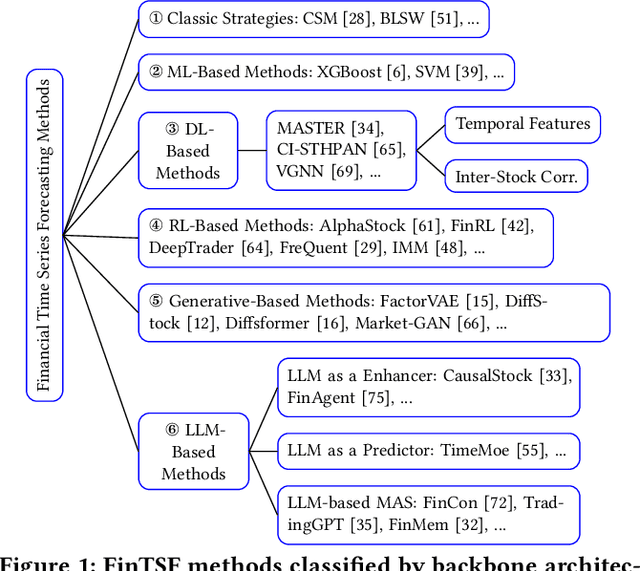



Abstract:Financial time series (FinTS) record the behavior of human-brain-augmented decision-making, capturing valuable historical information that can be leveraged for profitable investment strategies. Not surprisingly, this area has attracted considerable attention from researchers, who have proposed a wide range of methods based on various backbones. However, the evaluation of the area often exhibits three systemic limitations: 1. Failure to account for the full spectrum of stock movement patterns observed in dynamic financial markets. (Diversity Gap), 2. The absence of unified assessment protocols undermines the validity of cross-study performance comparisons. (Standardization Deficit), and 3. Neglect of critical market structure factors, resulting in inflated performance metrics that lack practical applicability. (Real-World Mismatch). Addressing these limitations, we propose FinTSB, a comprehensive and practical benchmark for financial time series forecasting (FinTSF). To increase the variety, we categorize movement patterns into four specific parts, tokenize and pre-process the data, and assess the data quality based on some sequence characteristics. To eliminate biases due to different evaluation settings, we standardize the metrics across three dimensions and build a user-friendly, lightweight pipeline incorporating methods from various backbones. To accurately simulate real-world trading scenarios and facilitate practical implementation, we extensively model various regulatory constraints, including transaction fees, among others. Finally, we conduct extensive experiments on FinTSB, highlighting key insights to guide model selection under varying market conditions. Overall, FinTSB provides researchers with a novel and comprehensive platform for improving and evaluating FinTSF methods. The code is available at https://github.com/TongjiFinLab/FinTSBenchmark.
MPO: An Efficient Post-Processing Framework for Mixing Diverse Preference Alignment
Feb 25, 2025Abstract:Reinforcement Learning from Human Feedback (RLHF) has shown promise in aligning large language models (LLMs). Yet its reliance on a singular reward model often overlooks the diversity of human preferences. Recent approaches address this limitation by leveraging multi-dimensional feedback to fine-tune corresponding reward models and train LLMs using reinforcement learning. However, the process is costly and unstable, especially given the competing and heterogeneous nature of human preferences. In this paper, we propose Mixing Preference Optimization (MPO), a post-processing framework for aggregating single-objective policies as an alternative to both multi-objective RLHF (MORLHF) and MaxMin-RLHF. MPO avoids alignment from scratch. Instead, it log-linearly combines existing policies into a unified one with the weight of each policy computed via a batch stochastic mirror descent. Empirical results demonstrate that MPO achieves balanced performance across diverse preferences, outperforming or matching existing models with significantly reduced computational costs.
Few-Shot Adaptation of Training-Free Foundation Model for 3D Medical Image Segmentation
Jan 15, 2025
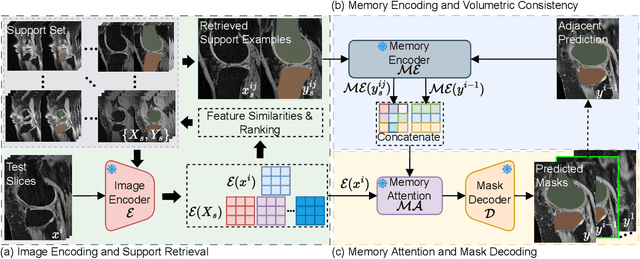

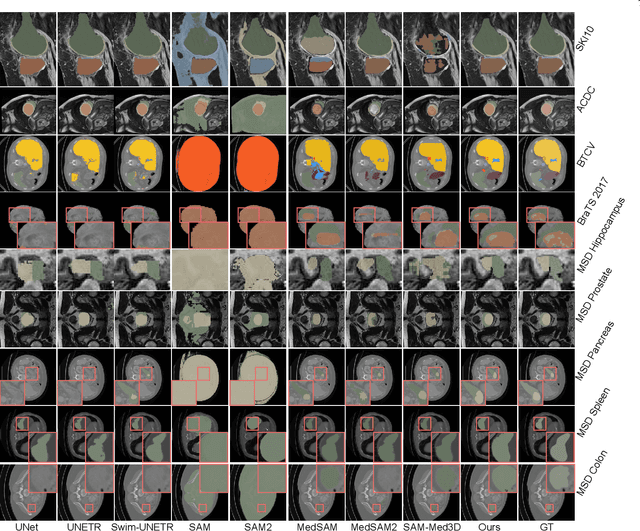
Abstract:Vision foundation models have achieved remarkable progress across various image analysis tasks. In the image segmentation task, foundation models like the Segment Anything Model (SAM) enable generalizable zero-shot segmentation through user-provided prompts. However, SAM primarily trained on natural images, lacks the domain-specific expertise of medical imaging. This limitation poses challenges when applying SAM to medical image segmentation, including the need for extensive fine-tuning on specialized medical datasets and a dependency on manual prompts, which are both labor-intensive and require intervention from medical experts. This work introduces the Few-shot Adaptation of Training-frEe SAM (FATE-SAM), a novel method designed to adapt the advanced Segment Anything Model 2 (SAM2) for 3D medical image segmentation. FATE-SAM reassembles pre-trained modules of SAM2 to enable few-shot adaptation, leveraging a small number of support examples to capture anatomical knowledge and perform prompt-free segmentation, without requiring model fine-tuning. To handle the volumetric nature of medical images, we incorporate a Volumetric Consistency mechanism that enhances spatial coherence across 3D slices. We evaluate FATE-SAM on multiple medical imaging datasets and compare it with supervised learning methods, zero-shot SAM approaches, and fine-tuned medical SAM methods. Results show that FATE-SAM delivers robust and accurate segmentation while eliminating the need for large annotated datasets and expert intervention. FATE-SAM provides a practical, efficient solution for medical image segmentation, making it more accessible for clinical applications.
Multi-modal and Multi-scale Spatial Environment Understanding for Immersive Visual Text-to-Speech
Dec 17, 2024Abstract:Visual Text-to-Speech (VTTS) aims to take the environmental image as the prompt to synthesize the reverberant speech for the spoken content. The challenge of this task lies in understanding the spatial environment from the image. Many attempts have been made to extract global spatial visual information from the RGB space of an spatial image. However, local and depth image information are crucial for understanding the spatial environment, which previous works have ignored. To address the issues, we propose a novel multi-modal and multi-scale spatial environment understanding scheme to achieve immersive VTTS, termed M2SE-VTTS. The multi-modal aims to take both the RGB and Depth spaces of the spatial image to learn more comprehensive spatial information, and the multi-scale seeks to model the local and global spatial knowledge simultaneously. Specifically, we first split the RGB and Depth images into patches and adopt the Gemini-generated environment captions to guide the local spatial understanding. After that, the multi-modal and multi-scale features are integrated by the local-aware global spatial understanding. In this way, M2SE-VTTS effectively models the interactions between local and global spatial contexts in the multi-modal spatial environment. Objective and subjective evaluations suggest that our model outperforms the advanced baselines in environmental speech generation. The code and audio samples are available at: https://github.com/AI-S2-Lab/M2SE-VTTS.
 Add to Chrome
Add to Chrome Add to Firefox
Add to Firefox Add to Edge
Add to Edge